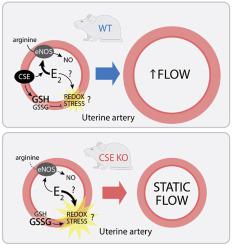Redox Biology ( IF 11.4 ) Pub Date : 2020-12-08 , DOI: 10.1016/j.redox.2020.101827 Rachael Bok 1 , Damian D Guerra 2 , Ramón A Lorca 1 , Sara A Wennersten 3 , Peter S Harris 4 , Abhishek K Rauniyar 4 , Sally P Stabler 5 , Kenneth N MacLean 6 , James R Roede 4 , Laura D Brown 7 , K Joseph Hurt 8

|
During pregnancy, estrogen (E2) stimulates uterine artery blood flow (UBF) by enhancing nitric oxide (NO)-dependent vasodilation. Cystathionine γ-lyase (CSE) promotes vascular NO signaling by producing hydrogen sulfide (H2S) and by maintaining the ratio of reduced-to-oxidized intracellular glutathione (GSH/GSSG) through l-cysteine production. Because redox homeostasis can influence NO signaling, we hypothesized that CSE mediates E2 stimulation of UBF by modulating local intracellular cysteine metabolism and GSH/GSSG levels to promote redox homeostasis. Using non-pregnant ovariectomized WT and CSE-null (CSE KO) mice, we performed micro-ultrasound of mouse uterine and renal arteries to assess changes in blood flow upon exogenous E2 stimulation. We quantified serum and uterine artery NO metabolites (NOx), serum amino acids, and uterine and renal artery GSH/GSSG. WT and CSE KO mice exhibited similar baseline uterine and renal blood flow. Unlike WT, CSE KO mice did not exhibit expected E2 stimulation of UBF. Renal blood flow was E2-insensitive for both genotypes. While serum and uterine artery NOx were similar between genotypes at baseline, E2 decreased NOx in CSE KO serum. Cysteine was also lower in CSE KO serum, while citrulline and homocysteine levels were elevated. E2 and CSE deletion additively decreased GSH/GSSG in uterine arteries. In contrast, renal artery GSH/GSSG was insensitive to E2 or CSE deletion. Together, these findings suggest that CSE maintenance of uterine artery GSH/GSSG facilitates nitrergic signaling in uterine arteries and is required for normal E2 stimulation of UBF. These data have implications for pregnancy pathophysiology and the selective hormone responses of specific vascular beds.
中文翻译:

胱硫醚γ-裂解酶通过谷胱甘肽体内稳态促进雌激素刺激的子宫动脉血流
在怀孕期间,雌激素(E 2)通过增强一氧化氮(NO)依赖性血管舒张作用来刺激子宫动脉血流(UBF)。胱硫醚γ-裂解酶(CSE)通过产生硫化氢(H 2 S)并通过产生1-半胱氨酸来维持还原型与氧化型细胞内谷胱甘肽(GSH / GSSG)的比例来促进血管NO信号传导。因为氧化还原稳态可以影响NO信号传导,所以我们假设CSE通过调节局部细胞内半胱氨酸代谢和GSH / GSSG水平来促进氧化还原稳态来介导UBF的E 2刺激。使用未怀孕的卵巢切除和野生型CSE(CSE KO)小鼠,我们对小鼠子宫和肾动脉进行了超声检查,以评估外源性E引起的血流变化2刺激。我们量化了血清和子宫动脉NO代谢物(NO x),血清氨基酸以及子宫和肾动脉GSH / GSSG。WT和CSE KO小鼠表现出相似的基线子宫和肾脏血流。与野生型不同,CSE KO小鼠未表现出预期的E 2对UBF的刺激。肾血流量是Ë 2不敏感的两个基因型。虽然血清和子宫动脉NO X在基线基因型之间相似,E 2降低NO X在CSE KO血清。CSE KO血清中的半胱氨酸也较低,而瓜氨酸和高半胱氨酸水平则升高。Ë 2和CSE缺失会加重子宫动脉GSH / GSSG的降低。相反,肾动脉GSH / GSSG对E 2或CSE缺失不敏感。在一起,这些发现表明,CSE维持子宫动脉GSH / GSSG有助于子宫动脉中的硝化信号传导,并且是正常E 2刺激UBF所必需的。这些数据对妊娠病理生理和特定血管床的选择性激素反应具有影响。


























 京公网安备 11010802027423号
京公网安备 11010802027423号